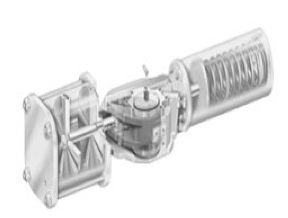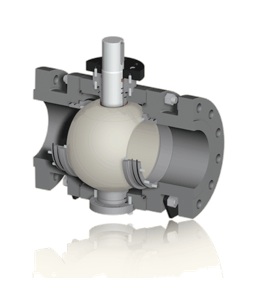A question was posed to me this week about why the OREDA failure rate for a solenoid valve was greater than the Failure Modes, Effects, and Diagnostic Analysis (FMEDA) results from exida for a specific manufacturer’s solenoid valve. The person asking the question was clearly challenging the exida…
exida explains Blog
- by Todd Stauffer
- Thursday, August 01, 2013
- Alarm Management
Alarm Rationalization: Alarm Objective Analysis (AOA)
Todd Stauffer, Director of Alarm Management at exida, takes you through a key part of the Alarm Rationalization process called Alarm Objective Analysis (AOA).
You will learn how to determine what alarms you need (and which one’s you don’t), how to eliminate nuisance alarms, and safely reduce the number…
- by Iwan van Beurden, CFSE
- Monday, July 29, 2013
- Certification
A Spring Return Scotch-Yoke Actuator with No Safe Failures! Really?

Look at the picture. What do you see? I see a spring return actuator with
- a diaphragm chamber
- a spring chamber
- the scotch-yoke mechanism
What are the high level potential failures for a ball valve?
- Scotch-yoke mechanism breaks, can no longer operate valve…
- by Iwan van Beurden, CFSE
- Monday, July 22, 2013
- Certification
A Ball Valve with Safe Failures! Really?

Look at the photo. What do you see? I see a ball valve with:
- a valve body
- a ball
- a stem that can turn the ball
What are the high level potential failures for a ball valve?
- Stem stuck, can no longer turn (dangerous) …
- by Michael Medoff , CFSE, CISA
- Friday, July 19, 2013
- Industrial Cybersecurity
Are Cybersecurity Servers Making Your ICS Less Cyber Secure?
ICS cybersecurity standards such as ISA 62443 (formerly ISA 99) and NERC CIP require operators to have policies and procedures in place to monitor and maintain their critical ICS cyber assets. For anything other than very small systems, the obvious choice is to implement systems…
- by Michael Medoff , CFSE, CISA
- Tuesday, July 16, 2013
- Industrial Cybersecurity
Cyber Security, Beyond the Internet: An Automation Engineer’s View
The world of automation has changed significantly over the past 30 years. I have fond memories of starting my career by calibrating, adjusting, and tuning pneumatic control loops while working my way through the electronic age right up to the present digital and cyber generation of automation. If you…
- by Dave Butler, CFSE
- Wednesday, July 10, 2013
- Software
Tracing and Validation Test Planning
Please see the first entry of the Requirements Management blog series here
Please see the second entry of the Requirements Management blog series here
So, you have a set of detailed safety requirements. You have derived them down to a level of detail you feel spells out…
- by Dave Butler, CFSE
- Tuesday, June 25, 2013
- Software
Allocation vs. Derivation
Please see the first entry of the Requirements Management blog series here.
The concepts of allocation and derivation are sometimes misunderstood when it comes to requirements management. This can lead to confusion and even to safety problems. The process of derivation involves the writing of a new requirement, …
- by Dave Butler, CFSE
- Wednesday, June 19, 2013
- Functional Safety
I have just one more, small change…
How many development teams have heard those few, innocent words uttered from Marketing/Management toward the end of the development phase of a project, only to have their schedule blown out of the water? The phase of development into which the change is introduced determines the size of the concentric…
- by John Yozallinas, CFSE
- Friday, June 14, 2013
- Functional Safety
Fire, Aim, Ready!
There is usually a natural order to things. But there are times when the natural order gets disrupted, and this could be for any number of reasons: we get busy, overloaded with tasks or information, tired, complacent, etc. But when you think about it, most of the excuses we…
- by Rick Smith
- Tuesday, June 11, 2013
- Functional Safety
Safety Training Benefits Safety Culture
While attending the Offshore Technology Conference, I heard a speaker make the point that studies substantiate that employees who are trained in safety are involved in fewer accidents. Those of us who promote and provide training in safety, this comes as no surprise. But it was his next…
- by John Yozallinas, CFSE
- Thursday, June 06, 2013
- Certification
If There Was ONE THING to Know About Functional Safety
Formalize your process.
Companies often have a pretty good hardware development process in place, dealing with electrical and mechanical drawings, bills of material, and the factory floor interface. Most of these processes are in place so the manufacturing department knows what to make and how to put it together. …
- by Steve Gandy, CFSP
- Tuesday, June 04, 2013
- Functional Safety
Why Do We Need You?
This was a question posed to me by an engineering contractor the other day. Although I found the question quite strange, it made me think “okay, why do they need us?” I suppose there are a few answers:
- Regarding the end user perspective, we exist to provide an independent third-party…
- by Dr. William Goble, CFSE
- Thursday, May 30, 2013
- Functional Safety
Make IEC 61511 into a Cookbook?
IEC 61508 and IEC 61511 are known as “performance” based standards. Specific design rules, as found in “prescriptive” standards, are not included, allowing for innovation and new technology, as well as creativity and advancement. However, it does imply that a certain level of competency is required.
Others would strongly…
- by Todd Stauffer
- Tuesday, May 28, 2013
- Alarm Management
When is an Independent Protection Layer (IPL) Not a Safeguard?
We are going to continue discussing the results from exida’s recently published industry benchmark survey on the practices for the use of alarms as safeguards and IPLs. Over 200 safety practitioners from around the world provided responses. This entry will discuss the relationship between alarms identified as safeguards and…
exida explains
The exida explains blog has been around for over five years and gives expert and sometimes candid insight into the world functional safety, alarm management, and industrial cybersecurity.
